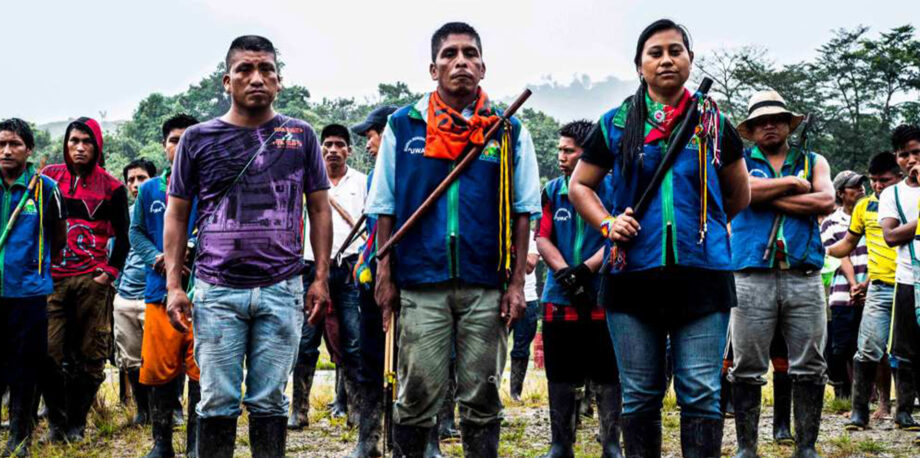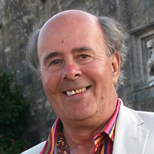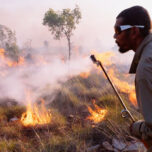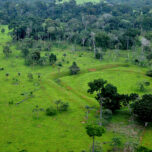November 13, 2019 — To reach the U’wa villages in the cloud forests of northeastern Colombia, you must cross the plain, head into the mountains, abandon cars, take to footpaths, ford rivers and then seek permission from tribal elders. It can take weeks.
I visited in 1997 with young California biologist Terry Freitas, one of the few westerners at that point to have been allowed in to U’wa territory to study indigenous ways to protect nature. His plan was to gain their trust, learn from them and possibly write a book.
The U’wa were defending their land against global oil companies, and we were met on the edge of their forests by a man named Betencaro. He had been forbidden by the tribal elders to take us into the group’s core, or sacred areas, but he invited us to his home. The short walk took over an hour because Betancaro stopped every few minutes to show us how the U’wa used and protected the forest, which they had lived in and managed for centuries.
To the outsider, the forest was dense and undisturbed. But to the U’wa, it was an all-in-one supermarket, farm and pharmacy. The root of one plant cured stomachaches, he said; the leaf of another was an anesthetic that left the mouth numb in a few seconds. Betancaro pointed out shrubs that were good for food, a flower that glowed in the dark, fruit that was sweeter than honey. Everything, from vines to make ropes to leaves that served as plates, had a use.
Betencaro explained how the U’wa protected their forest by following strict rules, only taking fallen fruit, never cutting some trees, hunting certain animals at precise times of the year and having core areas into which only shamans were allowed.
“That way there is enough for all. Our role [on Earth] is to protect the forest,” he told us.
Earlier this year, the Intergovernmental Science-Policy Platform on Biodiversity and Ecosystem Services (IPBES) published the most comprehensive study ever conducted into the state of the world’s nature. Drawing on some 15,000 sources, it reported to governments that some 1 million plant and animal species were threatened with extinction by human activities. It found nature declining globally at rates unprecedented in human history.
But it also recognized that indigenous peoples like the U’wa who hold traditional knowledge about how to protect nature are vital to protect future global biodiversity.
“They are often better placed than scientists to provide information on local biodiversity and environmental change, and are important contributors to the governance of biodiversity from local to global levels,” the IPBES noted.
Heritage of Humankind
The United Nations estimates that around 370 million people worldwide identify themselves as indigenous. While very few live as remotely as the U’wa, very many Asian, African and Latin American communities base the way they farm or use water and other resources on ancient practices and cultures they have tried and tested over generations.
More than 28% of the global land area is owned, used or managed by indigenous peoples, including more than 40% of terrestrial protected areas and 37% of “all remaining natural lands.”The importance of indigenous peoples for conservation is only slowly being recognized, says Stephen Garnett, a professor with the Conservation and Sustainable Livelihoods group at Charles Darwin University in Australia. Garnett says he was surprised to find in his research, published in 2018, that more than 28% of the global land area is owned, used or managed by indigenous peoples, including more than 40% of terrestrial protected areas and 37% of “all remaining natural lands.”
“Our results add to the growing evidence that recognizing Indigenous Peoples’ rights to land, benefit sharing and institutions is essential to meeting local and global conservation goals,” Garnett and colleagues write in the paper.
Their closeness to the land has enabled indigenous communities to live sustainably, says Fikret Berkes, professor emeritus at the University of Manitoba and Canada Research Chair in Community-Based Resource Management.
“Traditional knowledge is part of the heritage of humankind. It is the library of knowledge that people have of the environments they live in. We need different knowledges. Future generations will need this to survive,” he says.
The western way to protect nature has traditionally paid little attention to indigenous people, says Eli Enns, co-chair of the Indigenous Circle of Experts, which is advising the Canadian government on how to use an indigenous approach to conservation.
Protected areas and national parks have been created by taking land from indigenous peoples and evicting them, he says. “Indigenous people were excluded from conservation programs and even forcibly evicted from the land. They were seen as obstacles to conservation and nature protection, and their knowledge was ignored or dismissed,” says Enns.
Speaking at the Luc Hoffmann Institute in Vienna in September, he said the global collapse of biodiversity stems from a dominant western worldview that separates humans from nature and encourages the excessive exploitation of natural resources.
“Indigenous knowledge is about the interconnectedness of things. It tries to increase abundance. The Western approach is to see the world in pieces and to profit from it,” he said.
Biologist Debal Deb works with communities in India to protect fast-disappearing plant species. Indigenous communities respect nature more because they rely on a knowledge system distilled from generations of observation and practice, he wrote in an email.
“[T]he whole community possesses the land, forest and water bodies as commons, with a set of user rules,” he wrote. “Their worldview (including the governance of the commons) does not differentiate the forest/land from themselves — unlike the Judeo-Christian-Islamic worldview of hierarchical view of human and (the rest of) nature.”
Many indigenous societies summarize their knowledge “in the forms of folklores and folk institutions like ‘sacred groves,’ ‘sacred ponds’ and ‘sacred species’ — that prohibit the destruction of certain resource species and their habitats. Re-planting of trees after felling and prohibition of pollution of rivers upstream are a part of such traditional practices, based on the ancient experience of profligate use of resources,” Deb wrote.
“It took years for indigenous knowledge to get known. Now we are relying on it to deliver biodiversity. [Indigenous peoples] have been delivering for all these years but have been quite unappreciated,” says Jon Hutton, director of the Luc Hoffmann Institute and former head of the U.N.’s World Conservation Monitoring Centre in Cambridge, U.K.
Keeping Species Numbers High
Research shows conclusively that nature is declining less rapidly on lands that indigenous people manage than in other areas. Deforestation rates in Colombia, Brazil and Bolivia are significantly lower in places where indigenous people securely hold land, according to Peter Veit, director of the land and resource rights initiative at the World Resources Institute in Washington, D.C.
“When indigenous peoples have communal control of land, biodiversity loss is noticeably less.” – Peter Veit“When indigenous peoples have communal control of land, biodiversity loss is noticeably less. Tenure security provides indigenous peoples and communities greater assurance that they will benefit from investments in their land,” he says.
Researchers who analyzed land use and species data from more than 15,000 areas of Australia, Brazil and Canada found that the total numbers of birds, mammals, amphibians and reptiles were highest on lands managed or co-managed by indigenous communities.
“From frogs and songbirds right up to large mammals like grizzly bears, jaguars and kangaroos, biodiversity was richest in indigenous-managed lands,” co-author Ryan Germain, a postdoctoral fellow at Cornell University, said in a press release.
“This suggests that it’s the land-management practices of many indigenous communities that are keeping species numbers high,” said Carleton University conservation biologist and co-lead author Richard Schuster in a statement. “Going forward, collaborating with Indigenous land stewards will likely be essential in ensuring that species survive and thrive.”
Sophisticated Systems
Other studies describe some of the sophisticated natural resource management systems that indigenous peoples traditionally use and which are now being adopted more widely. They include a 1,200-year-old way to grow fish and rice together in China that greatly reduces the need for pesticides and chemical fertilizers; Aboriginal fire management techniques developed thousands of years ago to protect Australian landscapes; indigenous knowledge of reindeer herders in the Arctic; and traditional ways to allow Pacific fish stocks to recover.

In Australia, ancient Aboriginal techniques are informing modern fire management. Photo courtesy of Wunambal Gaambera Aboriginal Corporation/Russell Ord
Other practices from which Western society could benefit include 3,500-year-old rainwater harvesting techniques in India, indigenous farming methods in the highlands of Tanzania, and practices that tribal groups have traditionally used to adapt to climate change in Polynesia.
A 2013 study of people living near the Kpashimi forest in Rivers state, Nigeria, by geography lecturer Jinbrin Abdullahi of Ahmadu Bello University and colleagues, detailed how a traditional society protected its environment by following cultural and ecological rules. Taboos and beliefs forbade the killing of some animals at certain times, fire was used to increase the regeneration of trees, human impact was restricted in designated sacred places, and harvesting had to be limited. To promote biodiversity and conservation, hunting was restricted to certain species in specific seasons to allow breeding. Fruit could only be picked from the ground and fruit trees could not be cut down; medicinal plants could only be debarked on one side.
“People and governments must now move away from the narrow thinking that the Western style of science is the only science there is. From this viewpoint, the vast body of scientific expertise developed in diverse societies and cultures is discounted and ignored,” says geneticist Suman Sahai, chair of the Gene Campaign.
The biodiversity being managed freely by indigenous peoples around the world is widely threatened in a new scramble for resources, says Fiona Watson, director of research and advocacy of international human rights group Survival International.“There are ways to use forests and keep them. You can use resources and maintain them. Indigenous knowledge includes knowledge accumulated over thousands of years. Communities have vetted solutions and knowledge systems over time,” she says.
But the biodiversity being managed freely by indigenous peoples around the world is widely threatened in a new scramble for resources, says Fiona Watson, director of research and advocacy of international human rights group Survival International.
“Throughout the world, indigenous peoples are on the front line of destructive development and are paying with their lives. If it was not for them, a lot more forests would have been felled by now and much biodiversity would have been lost. They are the only ones defending the forests in the Amazon and India,” she says.
Human Rights Crisis
The international non-governmental organization Global Witness concluded that around 40% of the 200 people who were murdered in 2017 for defending their lands or resources from international business were indigenous, reported Vicky Tauli-Corpuz, an indigenous leader from the Kankanaey Igorot people in the Philippines and U.N. special rapporteur on the rights of indigenous peoples.
“This violence is a human rights crisis, but it is also a threat to everyone who depends on nature. Unfortunately, even those people who go into indigenous lands to seek the knowledge of how to protect nature are in danger,” Tauli-Corpuz says.
In the months after I visited the U’Wa, Terry Freitas campaigned to stop the western oil companies exploiting the oil and destroying the U’Wa lands.
Two years later, with the U’wa fight against the oil companies well known and the oil companies in retreat, Freitas visited the mountains of Colombia once more, this time with two U.S. activists. As they left U’Wa lands, they were kidnapped and killed.
In the outcry that followed, the companies stopped their prospecting and pulled out of U’Wa lands.
The book Terry Freitas hoped to write about the U’Wa people’s unique relationship with nature was never written, but the role of indigenous knowledge in protecting biodiversity is being more widely recognized.
Related Posts
Ensia shares solutions-focused stories free of charge through our online magazine and partner media. That means audiences around the world have ready access to stories that can — and do — help them shape a better future. If you value our work, please show your support today.
Yes, I'll support Ensia!




Much Love to You ALL, NEW EARTH SHAPERS.
Ancient Sacred Spiritual Natural Sciences... Indigenous Knowledge... Old WISDOM.
I Am 2Crows Says the Raven...
I Am KoKopelli Says the Flute...
The EAGLE of the North Will Soon Meet With the CONDOR of the South.... Get ReadY EARTH WARRIORS... The Storm is Approaching Fast.
OldSouls
It's Time
Much Love.
✨✨